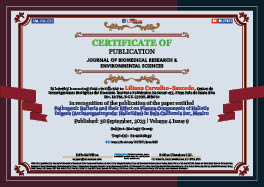Liliana Carvalho-Saucedo* and Jose Luis Gutierrez Gonzalez
Volume4-Issue9
Dates: Received: 2023-09-13 | Accepted: 2023-09-28 | Published: 2023-09-30
Pages: 1370-1373
Abstract
Background: In Mexico Haliotis fulgens catch decreased considerably in 2012. In other countries like U.S.A., Australia, and Tasmania, their decline was associated with death by pathogens. Goals. We studied the bacterial effect on the concentration of some biochemical components of haemolymph of H. fulgens.
Methods: Eight apparently sick abalone of culture and five healthy abalone were collected in 2013. The concentration of glucose, total proteins, albumin, globulins, and bacterial species were obtained.
Results: We found Vibrio alginolyticus, Acinetobacter lwoffii, Serratia sp. y Aeromonas hydrophila. The diseased abalone had a higher total protein concentration than the healthy abalone (1.20 g/dl and 1.09 g/dl, p < 0.05, respectively). The increase of glucose, total proteins, globulins, and albumins was directly proportional with bacterial effect.
Conclusion: This is the first report of V. alginolyticus, A. lwoffii, Serratia sp. y A. hydrophila in H. fulgens, cultivated in La Boca, Baja California Sur, Mexico. A regression analysis showed a negative effect on the biochemical components of hemolymph due to these bacteria.
FullText HTML
FullText PDF
DOI: 10.37871/jbres1805
Certificate of Publication

Copyright
© 2023 Carvalho-Saucedo L, et al. Distributed under Creative Commons CC-BY 4.0
How to cite this article
Carvalho-Saucedo L, Gutiérrez González JL. Pathogenic Bacteria and their Effect on Plasma Components of Haliotis fulgens (Archaeogastropoda: Haliotidae) in Baja California Sur, Mexico. J Biomed Res Environ Sci. 2023 Sep 30; 4(9): 1370- 1373. doi: 10.37871/jbres1805, Article ID: JBRES1805, Available at: https://www.jelsciences.com/articles/jbres1805.pdf
Subject area(s)
References
- Ponce-Díaz G, Lluch-Cota SE, Bautista-Romero JJ, Lluch-Belda D. Caracterización multiescala de la temperatura del mar en una zona de bancos de abulón (Haliotis spp.) en Bahía Asunción, Baja California Sur, México. Ciencias Marinas. 2003;29(3):291-303.
- Lafferty KD, Kuris AM. Mass mortality of abalone, Haliotis cracherodii, on the California Channel Islands: Tests of epidemiological hypotheses. Marine Ecology Progress Series. 1993;96:239-248. doi: 10.3354/meps096239.
- Handlinger J, Carson J, Donachie L, Gabor L, Taylor D. Bacterial infection in Tasmanian farmed abalone: Causes, pathology, farm factors and control options. In: Walker P, Lester R, Bondad-Reantaso MG, editors. Diseases in Asian Aquaculture V. Fish Health Section. Asian Fisheries Society: Manila; 2005. p.289-299.
- Donaghy L, Hong HK, Lambert C, Park HS, Shim WJ, Choi KS. First characterisation of the populations and immune-related activities of hemocytes from two edible gastropod species, the disk abalone, Haliotis discus discus and the spiny top shell, Turbo cornutus. Fish Shellfish Immunol. 2010 Jan;28(1):87-97. doi: 10.1016/j.fsi.2009.10.006. Epub 2009 Oct 12. PMID: 19822215.
- Najiah M, Nadirah M, Lee KL, Lee SW, Wendy W, Ruhil HH, Nurul FA. Bacteria flora and heavy metals in cultivated oysters Crassostrea iredalei of Setiu Wetland, East Coast Peninsular Malaysia. Vet Res Commun. 2008 Jun;32(5):377-81. doi: 10.1007/s11259-008-9045-y. Epub 2008 Mar 28. PMID: 18369732.
- Calderón-Liévanos S. Respuesta fisiológica del abulón azúl (Haliotis fulgens, Philippi 1845) por efecto combinado de Hipoxia y estrés térmico, (Tesis Maestría). México: Centro de Investigaciones Biológicas del Noroeste. 2015.
- Abdul-Aziz KK. The health status and genetic variations of the bivalve, Pinctala radiate affected by environmental pollution. Journal of Environmental & Analytical Toxicology. 2012;2:138-145. doi: 10.4172/2161-0525.1000138.
- Andreeva AM. Structure of fish serum albumins. Journal of Evolutionary Biochemistry and Physiology. 2010;46(2):135-144. doi: 10.1134/S0022093010020018.
- Urquizo Ayala G, Arteaga Coariti R. Proteína C reactiva en el diagnóstico y pronóstico de enfermedades infecciosas en pacientes geriátricos. Rev Méd. 2017;23(2):69-73.
- Defoirdt T, Boon N, Bossier P, Verstraete W. Disruption of bacterial quorum sensing: An unexplored strategy to fight infections in aquaculture. Aquaculture. 2004;240:69-88. doi: 10.1016/j.aquaculture.2004.06.031.
- Romalde JL. Héroes o villanos: Bacterias asociadas a los cultivos de moluscos. Revista AquaTIC. 2012;37:45-59.
- Lee KK, Liu PC, Chen CY, Huang CY. The implication of ambient temperature with outbreak of vibriosis in cultured small abalone, Haliotis diversicolor supertexta Lischke. Journal of Thermal Biology. 2001;26:585-587. doi: 10.1016/S0306-4565(01)00004-3.
- Anguiano-Beltrán C, Lizárraga-Partida ML, Searcy-Bernal R. Effect of Vibrio alginolyticus on larval survival of the blue mussel Mytilus galloprovincialis. Dis Aquat Organ. 2004 May 5;59(2):119-23. doi: 10.3354/dao059119. PMID: 15212277.
- Travers MA, Le Goïc N, Huchette S, Koken M, Paillard C. Summer immune depression associated with increased susceptibility of the European abalone, Haliotis tuberculata to Vibrio harveyi infection. Fish Shellfish Immunol. 2008 Dec;25(6):800-8. doi: 10.1016/j.fsi.2008.08.003. Epub 2008 Aug 22. PMID: 18786640.






























































